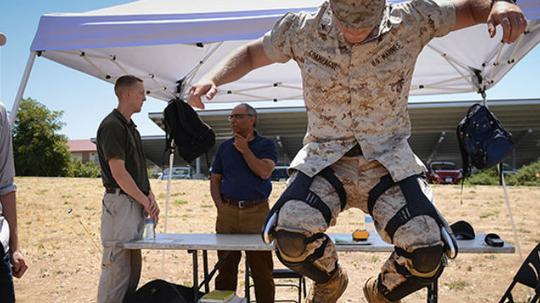
Soldiers and Marines haul more than 17 pounds of batteries on their backs for an average 72-hour mission. Those batteries account for more than 20 percent of the weight in rucksacks that often weigh over 80 pounds and have caused serious back and muscle problems for troops in both services.
The U.S. Army and Marine Corps want to drastically reduce that weight by cutting down the amount of batteries soldiers and Marines carry with a combination of energy harvesters, power managers, miniature solar panels and lightweight conformal batteries. Officials from both services want the help of startups and small businesses to uncover those solutions.
Army and Marine energy leaders spoke about their efforts to reach out to these innovators in Arlington, Va., on June 22 at the Energy Innovations Summit hosted by Tandem National Security Innovations (TandemNSI), a public-private partnership that connects technology entrepreneurs with national security opportunities.
Jose Collazo, an energy harvesting engineer for the Army, explained how his team is experimenting with different types of devices that collect energy expended by soldiers and Marines and use it to power the growing number devices that require power.
"We look at how many batteries a soldier needs to take on a mission and how much [weight] savings they are getting from an energy harvesting device,” Collazo said during the Military Mobile Power panel session at the summit. “The goal is to reduce the batteries they are taking because they have the ability to generate power on-the-go."
The Army and Marine Corps are working together on multiple energy harvesting programs to include a set of knee braces that converts movement into electricity. Called the Joint Infantry Company Prototype (JIC-P), the energy system has already won numerous awards to include a 2016 Business Intelligence Group Innovation Award and selected as a finalist in the Energy & Sustainability Award Category for the 2016 Edison Awards.
JIC-P is more than just knee braces, it’s a system that also includes a vest power manager that measures energy consumption, a central battery, a photovoltaic solar panel and a backpack that collects energy as it moves up and down on a Marine or soldier’s back.
"Every time you take a step, that backpack hits you in the back. So that’s a lot of energy. So if you could take that energy and … turn it into battery power you’ve killed two birds with one stone,” said Brian Kiviat, the deputy director for the Marine Corps Expeditionary Energy Office. “The Marine saves his knees and his ankles and he’s recharging his battery.”
The Army and Marine Corps plan on testing the JIC-P along with other energy harvesting systems, lightweight batteries and portable solar panels in a Spring 2017 test with 25 Marines and 25 soldiers.
Early tests on one version of the knee braces received mixed reviews with some users saying they were too bulky and tight around the thighs. Army and Marine Corps officials said those concerns have been addressed and to expect a lighter, sleeker version to be tested next year.
Along with energy harvesting, the Army is testing new materials to make batteries lighter and more powerful. Von Cresce, a scientist with the Army Research Laboratory who is researching lithium ion batteries, said the service is looking toward the automotive industry for new research on batteries.
He said at the energy summit that the Army is investigating lithium metal as one such material that has potential. The concern with lithium metal is the possibility it catches fire and causes an explosion, Cresce explained.
“There are only so many elements on the periodic table [to use as anodes],” Cresce said. “We would like to utilize lithium metal, for example, because even though it’s not particularly cheap it’s the most energy dense anode you could possibly have [for lithium ion batteries].”
The Army’s Soldier Power Team is developing lightweight, conformal batteries that soldiers can wear. One of the challenges is designing a battery that can be shot and not explode. Vijay Acharya, an engineer with Army PEO Soldier, said the service has developed a battery than can be shot at least three times and only smoke, not explode.
Small businesses, university researchers and entrepreneurs from the Washington D.C. region packed the Energy Innovations Summit to learn more about the Army, Marine Corps and Department of Energy programs to include local energy companies like Tumalow, Senseware, Wire Tough, and Ion Storage.
In March, Virginia-based accelerator Eastern Foundry hosted its Foundry Cup with a focus on portable power. Energy Intelligence, a small business based in New York, won the competition with its vehicle based system that collects energy when the vehicle brakes.
Kiviat said the Marine Corps and the other military services are always looking for companies like these, even if they have never done any work for the government before.
The Army Research Laboratory stood up its Open Campus program to connect with more university researchers and small businesses for topics like mobile power by offering these groups access to Army facilities and lab equipment.
Army and Marine Corps energy officials know they will need ideas from all corners to cut down on their dependence on batteries and lighten the loads on soldiers and Marines’ backs.
Michael Hoffman is the director of marketing at TandemNSI and can be reached at mhoffman@tandemnsi.com.




